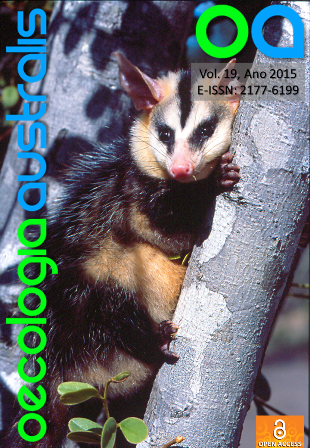Cranial morphometric analyses of the cryptic rodent species Akodon cursor and Akodon montensis (Rodentia, Sigmodontinae)
DOI:
https://doi.org/10.4257/oeco.2015.1901.09Keywords:
Sexual dimorphism, Akodon, Geometric morphometrics, Taxonomy, SigmodontinaeAbstract
Akodon cursor and A. montensis are two morphologically cryptic species of Akodontini rodents, undistinguishable by external, skin or qualitative cranial characters. As they can only be separated based on the presence or absence of a gall bladder or by their karyotypes, previously collected individuals in scientific collections that had not these characters annotated cannot be used in any further study with certainty. The purpose of our study was to assess whether geometric morphometrics of the skull and mandible could identify and separate specimens of A. cursor from those of A. montensis. We used 74 adult specimens (48 - A. cursor e 25 - A. montensis) previously identified by their karyotypes, from Southeastern Brazil. We digitized 24, 22, 25, 13 landmarks on images of their skulls (in dorsal, ventral, and lateral views) and mandible, respectively. We assessed size variation (sexual dimorphism and species differences) through t-tests and ANOVAs of centroid sizes of each structure and view, and shape variation through Goodall tests, MANOVAs and Canonical Variants Analyses on Procrustes coordinates. We found significant sexual size dimorphism (p<0.001) as well as size differences between species for all four views (p<0.001), with males larger and A. cursor larger than A. montensis, with an overlap between female A. cursor and male A. montensis specimens. We found significant sexual shape dimorphism in A. cursor (all views) and A. montensis (lateral view of the skull only), while the two species were completely separated in shape in all four views. Part of the observed variation in shape of the skull and mandible of the two species are likely related to size (allometry), while the lack of adequate ecological information hinders any evaluation of whether skull differences are related to feeding habits.
Downloads
Downloads
Additional Files
- camiladebarros, Figure 1. Landmarks.jpg (Português (Brasil))
- camiladebarros, Figure 2. CVA Dorsal.jpg (Português (Brasil))
- camiladebarros, Figure 3. CVA Lateral.jpg (Português (Brasil))
- camiladebarros, Figure 4. CVA Ventral.jpg (Português (Brasil))
- camiladebarros, Figure 5. CVA Mandible.jpg (Português (Brasil))
- camiladebarros, Cover Letter Akodon.pdf (Português (Brasil))
- camiladebarros, 955-6226-4-ED.docx (Português (Brasil))
- camiladebarros, 955-6226-2-ED.docx (Português (Brasil))


